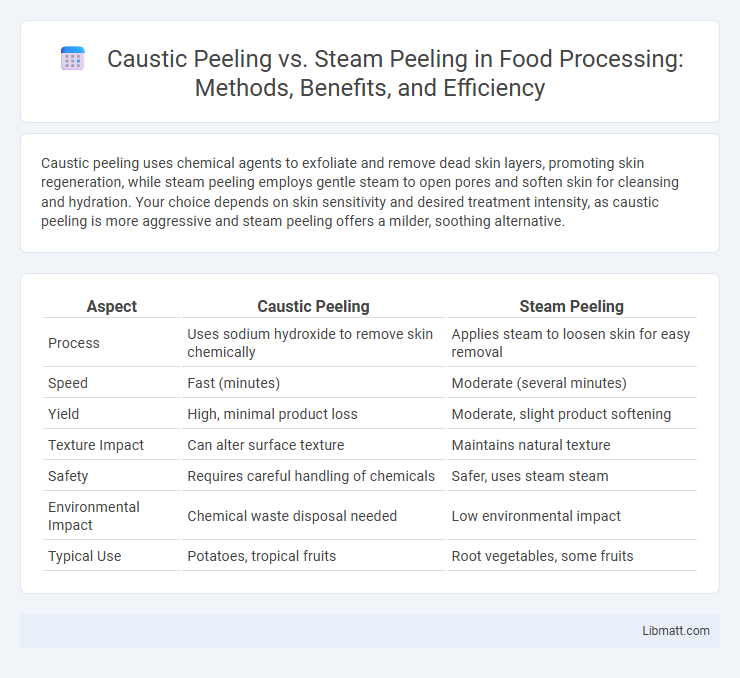Caustic peeling uses chemical agents to exfoliate and remove dead skin layers, promoting skin regeneration, while steam peeling employs gentle steam to open pores and soften skin for cleansing and hydration. Your choice depends on skin sensitivity and desired treatment intensity, as caustic peeling is more aggressive and steam peeling offers a milder, soothing alternative.
Table of Comparison
| Aspect | Caustic Peeling | Steam Peeling |
|---|---|---|
| Process | Uses sodium hydroxide to remove skin chemically | Applies steam to loosen skin for easy removal |
| Speed | Fast (minutes) | Moderate (several minutes) |
| Yield | High, minimal product loss | Moderate, slight product softening |
| Texture Impact | Can alter surface texture | Maintains natural texture |
| Safety | Requires careful handling of chemicals | Safer, uses steam steam |
| Environmental Impact | Chemical waste disposal needed | Low environmental impact |
| Typical Use | Potatoes, tropical fruits | Root vegetables, some fruits |
Introduction to Peeling Methods
Caustic peeling involves applying chemical agents, such as glycolic acid or trichloroacetic acid, to exfoliate the skin by breaking down dead cells and promoting regeneration. Steam peeling uses water vapor to open pores and soften the skin, facilitating gentle extraction and hydration without harsh chemicals. Both techniques aim to improve skin texture and clarity but differ significantly in application method and skin impact.
What Is Caustic Peeling?
Caustic peeling involves applying a chemical solution, typically containing acids like trichloroacetic acid or glycolic acid, to exfoliate and remove damaged skin layers. This method deeply penetrates the skin to treat issues such as acne scars, pigmentation, and wrinkles by promoting collagen production and skin renewal. Your choice between caustic peeling and steam peeling should consider skin sensitivity and desired results, as caustic peeling offers more intense and longer-lasting effects.
How Steam Peeling Works
Steam peeling works by using hot steam to gently exfoliate the skin, loosening dead cells and impurities without harsh chemicals. This method hydrates and softens your skin, promoting a smoother texture and improved absorption of skincare products. Compared to caustic peeling, steam peeling offers a gentler, non-invasive approach ideal for sensitive or delicate skin types.
Equipment and Process Requirements
Caustic peeling requires chemical agents such as sodium hydroxide and protective gear to safely handle the corrosive substances, with manual or automated application tools and rinsing stations for neutralization. Steam peeling utilizes high-pressure steam equipment to loosen fruit or vegetable skins, followed by mechanical peeling devices to remove softened layers, demanding specialized boilers and precise temperature control systems. Both methods involve distinct operational setups, but steam peeling offers a cleaner process with less chemical handling, which may influence Your selection based on equipment availability and safety considerations.
Efficiency and Speed Comparison
Caustic peeling uses chemical agents to remove dead skin layers efficiently, producing faster results in deep exfoliation compared to steam peeling, which softens skin gradually through heat and moisture. Steam peeling offers a gentler approach but requires longer treatment times to achieve visible effects, making it less suitable for urgent skin renewals. Your choice depends on balancing the need for quick, intensive exfoliation with a preference for mild, non-invasive skin care techniques.
Impact on Product Quality
Caustic peeling uses strong alkaline solutions to rapidly remove fruit skins, which can sometimes cause tissue damage and affect texture and flavor, potentially lowering product quality. Steam peeling applies controlled steam to loosen skins, preserving the fruit's structural integrity, resulting in better texture retention and enhanced sensory attributes. Therefore, steam peeling generally offers superior product quality due to its gentler impact on the fruit surface.
Environmental Considerations
Caustic peeling involves chemicals that can generate hazardous waste and require careful disposal to minimize environmental harm, while steam peeling uses high-pressure steam, which reduces chemical runoff and toxic byproducts. Steam peeling is considered more environmentally sustainable due to lower water pollution and safer waste management practices. Facilities opting for eco-friendly solutions often prefer steam peeling to meet stringent environmental regulations and reduce their carbon footprint.
Cost Analysis
Caustic peeling typically incurs lower initial costs due to inexpensive chemical agents but may lead to higher long-term expenses from skin irritation management and potential damage repair. Steam peeling involves higher upfront investment in specialized equipment and maintenance but offers cost efficiency through minimal side effects and faster recovery times. Evaluating overall cost-effectiveness requires balancing immediate expenditures against long-term skincare outcomes and patient satisfaction.
Safety and Health Concerns
Caustic peeling involves the use of strong chemicals like sodium hydroxide, which can cause severe skin burns, respiratory irritation, and potential chemical exposure risks if not handled properly. Steam peeling is generally safer, using high-temperature steam to exfoliate the skin, minimizing chemical hazards, and reducing the risk of adverse reactions or long-term health effects. Proper ventilation and protective equipment are essential for caustic peeling procedures, while steam peeling requires careful temperature control to prevent burns or scalding.
Choosing the Best Peeling Method
Caustic peeling uses chemical agents like glycolic or salicylic acid to deeply exfoliate and rejuvenate your skin by removing dead cells and promoting collagen production, making it ideal for treating acne scars and pigmentation. Steam peeling leverages warm steam to open pores and soften the skin's surface, enhancing gentle exfoliation and hydration without harsh chemicals, suitable for sensitive skin types. Your choice should depend on your skin sensitivity, specific concerns, and desired intensity of treatment, with caustic peeling offering more potent results and steam peeling prioritizing comfort and hydration.
caustic peeling vs steam peeling Infographic

 libmatt.com
libmatt.com